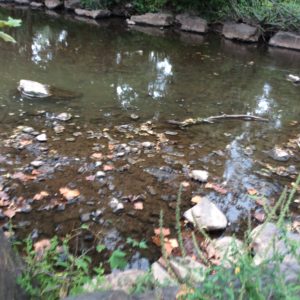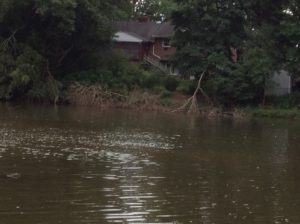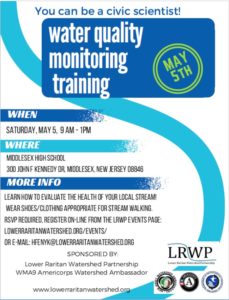May 11
@
9:00 am
–
1:00 pm
Please join us for our May visual habitat assessment training with the LRWP and WMA9 Americorps Watershed Ambassador Brianna Casario! (Here’s more on the LRWP’s water quality monitoring programs).
This FREE training on Saturday May 11 will run from 9 AM – 1 PM at the Middlesex High School, located at 300 John F Kennedy Dr, Middlesex, NJ 08846
We will start the morning with a lecture indoors, and then get out in the field to test our knowledge of streams and stream habitat.
Please wear clothing and footwear that you don’t mind getting wet and dirty.
RSVP required, E-mail Brianna Casario: wma9.njwap@gmail.com
Calling all Streamkeepers and Civic Scientists!
A healthy stream is a complex place. Vegetation grows along its banks, shading the stream and filtering pollutants before they enter the waters. Wildlife find shelter and food near and in its waters. And within the stream itself are fish, insects, and other organisms with specific needs for oxygen, food, and shelter. Certain land uses affect habitat quality and stream health. A stream corridor functions holistically, and any changes to a part may affect the entire habitat.
A habitat assessment is a summary of different characteristics of a stream segment that help us better understand the health of our area streams. When we understand issues that affect our streams, we can do a better job of protecting them.
Please join the LRWP and Americorps Watershed Ambassador Caitlin DiCara on Monday November 30 for a two-hour FREE virtual Stream Habitat Assessment training.
This training will detail the “how-tos” of assessing the health of our local streams in preparation for Spring 2021 monitoring.
We will also provide general overview of our adopt-a-stream and stream monitoring program, and answer participant questions about these program and program requirements.
This FREE training will run from 5:30-7:30 PM from the comfort of your own home. Registration required.
We look forward to seeing you on November 30!
Heather Fenyk
Jon Dugan
Caitlin DiCara, NJ Watershed Ambassador Program
For more information, contact Heather Fenyk: hfenyk@lowerraritanwatershed.org OR #908.349.0281
Click here for more info on the LRWP’s water quality monitoring programs
Calling all Streamkeepers and Citizen Scientists!
Please join us for our June 1 visual habitat assessment training with the LRWP’s Volunteer Monitoring Manager Jon Dugan! (Here’s more on the LRWP’s water quality monitoring programs).
This FREE training on Saturday June 1 will run from 9 AM – 1 PM at the Middlesex High School, located at 300 John F Kennedy Dr, Middlesex, NJ 08846
We will start the morning with a lecture indoors, and then get out in the field to test our knowledge of streams and stream habitat.
Please wear clothing and footwear that you don’t mind getting wet and dirty.
Registration required.
Article and Photos by Margo Persin, Rutgers Environmental Steward
Editor’s Note: In 2018 Margo Persin joined the Rutgers Environmental Steward program for training in the important environmental issues affecting New Jersey. Program participants are trained to tackle local environmental problems through a service project. As part of Margo’s service project she chose to conduct assessments of a local stream for a year, and to provide the data she gathered to the Lower Raritan Watershed Partnership (LRWP). Margo keeps a journal of her experiences, excerpts of which are included in the LRWP’s “Voices of the Watershed” column.
Internship Diary / August, 2018
For this visit to my assigned assessment site, I had new members of my ‘team’. It so happens that two of my godsons were visiting from London, UK, where they reside and go to school. Alex, 14 years old, and Mathieu, 12 years old, were presented with the option of participating as full team members to do a stream assessment at the Ambrose Brook. They readily agreed, and we set off for the stream site.
The day was partly cloudy upon arrival and proceeded to get more clouded over as our time at the stream advanced. I appreciated very much the extra eyes and hands, given that it would take a group effort to undertake and finish all the measurements required of the assessment. It was so nice to have the company and the opportunity to share this activity with them. They asked some pertinent questions in regard to the site, as well as concerning the focus of the project. We were armed with marker flags, tape measure and ruler, thermometer, stop watch, and the required forms to fill out. In addition, as a nod to my own childhood, I had dug out of storage the red plastic duckie that I had used so (too) many years ago when I was a child. After having sealed the seams with glue, it proved to be water ready and floatable, and was thrown into our equipment bag.
Upon arrival, we did a quick survey of the site. I gave the boys an overview of the project as we walked the required distance to mark off where we would take our measurements and set our marker flags. We were not particularly surprised to note that summer was on the wane, and the stream site showed the effects of the copious summer rain fall of this year and the subtle yet visible march of time on the greenery. There were a few trees already beginning to drop some leaves, apparent at their base as well as at the edges of the stream. Some windfallen branches had made their way into the stream on both sides, evidence of the frequent storms that had buffeted our area during the preceding summer months. In addition, the water level had risen, as marked by mud splashes on bushes, trunks and the mud banks. There were a few ducks and Canadian geese, who had vacated the surrounding lawns and walkways; that day, they were floating lazily on the water’s surface between the far bank and the island, oblivious to our presence.

Ambrose Brook, August 2018 – Margo Persin

High water at Ambrose Brook, August 2018 – Margo Persin
At that point, the boys and I got to work. Alex and I did the physical measuring, including wading to the middle of the stream to measure depth and velocity, while Mathieu took on the role of scribe and stop watch handler. The first order of business was to observe, consult and come to a shared decision in regard to water conditions. My team mates took their jobs seriously and we were able to arrive at mutually acceptable readings of turbidity and stream flow. The next order of business was to measure width, depth and velocity. Armed with the rubber duck and ruler, Alex waded to the starting point while I headed in the opposite direction. Mathieu had been instructed in the subtleties of the stop watch, and as the two of us with wet feet called out the various measurements and Mathieu proceeded to fill out the form. All of us – Alex, Mathieu, me, and the rubber duck – showed ourselves up to the task and we were able to finish that part of the assessment in due time.
After exiting the stream, it began to rain, so the three of us made a mad dash back to my vehicle, where we took refuge and worked through the rest of the form. The boys were more than willing to express their views in regard to stream characteristics as well as all the elements of high gradient monitoring. We reviewed the results in order to make sure that we were of one accord in regard to our observations and conclusions. They did a wonderful job of giving themselves over to the project, with determination, seriousness, intellectual curiosity, good humor, and dedication. After approximately one and half hours, we took our leave and headed to a nearby ice cream parlor for a well-deserved reward. Their company and participation were most welcome and I hope that this experience will inspire in them the desire to become involved with environmental projects of their own, whether on their own or in conjunction with their school curriculum.
Please join us for our May visual habitat assessment training with the LRWP and WMA9 Americorps Watershed Ambassador Rob Hughes! (Here’s more on the LRWP’s water quality monitoring programs).
This FREE training on Saturday May 5 will run from 9 AM – 1 PM at the Middlesex High School, located at 300 John F Kennedy Dr, Middlesex, NJ 08846
We will start the morning with a lecture indoors, and then get out in the field to test our knowledge of streams and stream habitat.
Please wear clothing and footwear that you don’t mind getting wet and dirty.
RSVP required, E-mail Rob Hughes: wsamb@raritanbasin.org

Please join us for our May visual habitat assessment training with the LRWP and WMA9 Americorps Watershed Ambassador Katee Meckler! (Here’s more on the LRWP’s water quality monitoring programs).
This FREE training will run from 9 AM – 1 PM at the Rutgers Cooperative Extension EARTH Center at Davidson’s Mill Pond, located at 42 Riva Avenue in North Brunswick.
We will start the morning with a lecture indoors, and then get out in the field to test our knowledge of streams and stream habitat.
Please wear clothing and footwear that you don’t mind getting wet and dirty.
RSVP required, E-mail Heather: hfenyk AT lowerraritanwatershed DOT org



